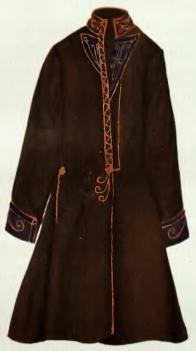Świętokrzyskie regional costume
Justyna Staszewska
Świętokrzyskie regional costume according to ethnographic materials of priest Władysław Siarkowski
A costume, that was an element which created identity of peasants and their ethnographic status, was an important aspect of how country community functioned in Kielce province. Priest Władysław Siarkowski in his publications emphasized that regional costume of surrounding villages inhabitants isn’t so expressive and colourful as costumes from Cracow and Sandomierz. As a main reason for that variance he considered the character of peasants, on whom „misery impressed a stamp”. In his view working on land, hard living conditions, poverty seem to curb cultural development of the countryside. The idea of flowery regional costume, that could have been a flagship of the region, is vanishing. The author laments low consciousness and as a result of it negligence and lack of esthetics. According to priest Siarkowski the image of Kielce regional costume reflects the state of mind of this social group. He refers to the inhabitants of the north part of Kielce province (1). In his „Notes from a trip to Busko area” he recalls:
„From Kielce to Morawica the type of people is totally different from peasants living between this village and Busko and further(...). People living near Kielce and Morawica situated in customs and traditions present less poetic beauty than their fellows from further areas.” (2).
Priest Władysław Siarkowski made observations that peasants living in the surroundings of Kielce were „scruffy in clothes” and „egoistic”. He believed that a reason for that cultural stagnation was alcohol overdose, which destroyed in the country people the innate ability of creative expression of the heritage of their tradition. People from the south part of the province, where the costume was more colourful, presented themselves in a slightly different way. On weekdays clothing consisted of russet coat, red four-cornered hat and long knee-high boots. Sunday best clothes were varied with coffee or navy blue russet coat with colourful insets and tassels (3).
We can find similar features of a peasant costume in a portrait of a peasant from Stopnica:
„This is a peasant from a village near Stopnica in Kielce province. He has a red four-cornered hat on his head, a navy blue „karazja” on his shirt and loose tunic, richly embroidered on the front part of the collar and in the area of the pockets and hands, there is no „suka”. There are red gothic „tabs” on sleeves. There are drill trousers, knee-high boots. White leather strap belt richly studded with bronze without Cracow clangs. Trade mark material. Cut and sewing is a masterpiece of a small town professional tailor” (4).
The look of clothing depended on the place of living, wealth and importance of a peasant family but in a moment when local costume began to attract scientists attention, it gained new cultural meaning:
„Costumes of country people are vivid souvenirs from the past, there are creation of regional fantasy, not borrowed from anybody but taken in from one’s own soil, pampered in one’s own forest, luxuriant under one’s own sky” (5).
On weekdays a very modest costume was used, which accordingly to changing seasons had different character (6). Summer male dress, worn everyday consisted of a shirt, linen trousers and a cap or a hat. According to custom a shirt was put inside trousers that were tied with leather strap belt. Female dress consisted of a linen shirt, a skirt and an apron. Both a skirt and an apron could be made of wool. Head was covered with a headscarf. Female peasants sometimes put on an apron, tied on the neck, at the back. In winter, apart from above mentioned clothes, peasants wore clothes made of frost proof material. They wore boots, basically not used in summer. Additionally people wore thick fur coats, men wrapped scarves around their necks and women wrapped aprons (7).
Kielecki costume had various patterns. Basically it referred to so called “ striped costume”, that combined in stripes different colour conventions. The promotion of folklore and Polish folk culture resulted in a slow discovery of the value of peasants clothing. We began to admire their variety of colours and designs, elaborateness of craft again. Thanks to a common use and solid craft these clothes became a pride of the region. Due to the efforts of ethnographers, institutions and Świętokrzyskie Weaving the regional costume is rightly called our cultural achievement.
- W. Siarkowski, Materials to etnography of Polish people from Kielce surrandings, p. 1…, p. (4).
- W.Siarkowski, Notes from a trip to Buskie side, „Gazeta Kielecka”, V. 3, 1872, nr 70, p. 278.
- Ibidem, p. 278-279.
- Contemporary outside parts of life of people in kieleckie, radomskie province…, p. 12.
- How are tales created, „Tygodnik Illustrowany” 1860, t. 2, nr 49, p. 457.
- J. Burszta, op. cit., p. 638.
- Contemporary outside parts of life of people in kieleckie, radomskie province …, p. 12-13.



 projekt współfinansowany w ramach programu
projekt współfinansowany w ramach programu